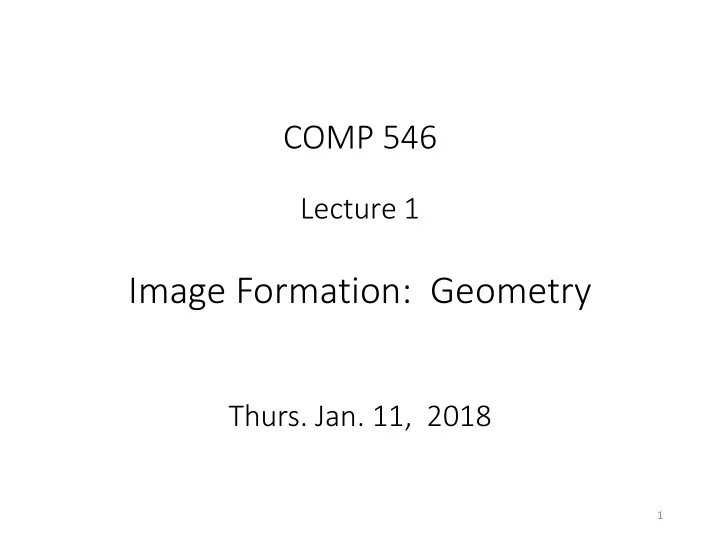

COMP 546 Lecture 1 Image Formation: Geometry Thurs. Jan. 11, 2018 1
Origins of spatial vision (500 million years ago?) photoreceptor array (eye) “brain” legs
Origins of spatial vision
Origins of spatial vision
Origins of spatial vision Predator arrives, but no change in light level received by this cell. predator
Origins of spatial vision Some change in light level predator received by this cell.
Origins of spatial vision predator If right cell measures decrease in light, then move right.
Evolution of eyes eye As pit becomes more concave, angular resolution improves (but amount of light decreases)
poor large aperture angular resolution good angular resolution small aperture
Radians q 𝜄 𝑠𝑏𝑒𝑗𝑏𝑜𝑡 = 𝑏𝑠𝑑𝑚𝑓𝑜𝑢ℎ 𝑝𝑜 𝑑𝑗𝑠𝑑𝑚𝑓 𝑠𝑏𝑒𝑗𝑣𝑡 𝑝𝑔 𝑑𝑗𝑠𝑑𝑚𝑓
Radians vs. degrees q 180 𝑒𝑓𝑠𝑓𝑓𝑡 180 𝜄 𝑠𝑏𝑒𝑗𝑏𝑜𝑡 ∗ = 𝜄 * 𝑒𝑓𝑠𝑓𝑓𝑡 𝜌 𝑠𝑏𝑒𝑗𝑏𝑜𝑡 𝜌 1 𝑠𝑏𝑒𝑗𝑏𝑜 ≈ 57 𝑒𝑓
Small angle approximation 𝜄 2 𝜄 ≈ 2 𝑢𝑏𝑜 𝜄 𝜄 2 2 12
Aperture angle from a few slides ago…. eye camera 13
“F number“ (photography) camera q aperture A “focal length” f 𝐺 𝑜𝑣𝑛𝑐𝑓𝑠 ≡ 𝑔 1 𝐵 ≈ q 14
ASIDE: camera 5 mm aperture A “focal length” f 50 mm 𝐺 𝑜𝑣𝑛𝑐𝑓𝑠 ≡ 𝑔 𝐵 = 50 5 = 10 15
eye (ignore lens) 5 mm aperture A length f 25 mm 𝐺 𝑜𝑣𝑛𝑐𝑓𝑠 ≡ 𝑔 𝐵 = 25 5 = 5 16
Visual Angle 𝛽 𝛽 ≈ 𝑝𝑐𝑘𝑓𝑑𝑢 ℎ𝑓𝑗ℎ𝑢 𝑒𝑗𝑡𝑢𝑏𝑜𝑑𝑓 17
Visual Angle 𝛽 𝛽 ≈ 𝑗𝑛𝑏𝑓 𝑡𝑗𝑨𝑓 𝑝𝑔 𝑝𝑐𝑘𝑓𝑑𝑢 𝑒𝑗𝑏𝑛𝑓𝑢𝑓𝑠 𝑝𝑔 𝑓𝑧𝑓𝑐𝑏𝑚𝑚 18
Two different concepts Aperture angle Visual angle 19
Visual Angle Example 1 57 𝑑𝑛 (arm ′ s length) Finger nail 𝛽 1 𝑑𝑛 𝑛 𝑝𝑐𝑘𝑓𝑑𝑢 ℎ𝑓𝑗ℎ𝑢 1 𝑑𝑛 𝛽 ≈ = = 1 degree 180 𝑒𝑗𝑡𝑢𝑏𝑜𝑑𝑓 20 𝑑𝑛 𝜌
Visual Angle Example 2 18 𝑛 𝛽 31.4 𝑑𝑛 𝜌 10 𝑛 𝑝𝑐𝑘𝑓𝑑𝑢 ℎ𝑓𝑗ℎ𝑢 𝜌 𝛽 ≈ = 18 𝑛 = 180 𝑠𝑏𝑒𝑗𝑏𝑜𝑡 = 1 degree 𝑒𝑗𝑡𝑢𝑏𝑜𝑑𝑓 21
Example 3: moon 1 Visual angle of moon is about 2 𝑒𝑓. 22
Units of visual angle 180 1 radian = deg 𝜌 1 deg = 60 minutes (or “ arcmin ”) 1 minute = 60 seconds (or “ arcsec ”) 23
Image position (X, Y, Z ) (x, y) pinhole camera mode 24
Pinhole camera 𝑍 (X, Y, Z ) 𝑌 (0, 0) 𝑎 (x, y) image plane behind pinhole 25
View from side (YZ) 𝑍 ( Y, Z ) 𝑎 y pinhole position (0, 0, 0 ) 𝑧 𝑧 𝑔 = 𝑍 image 𝑎 plane Z = - f 26
View from above (XZ) 𝑌 𝑎 x pinhole (X, Z ) position (0, 0, 0 ) 𝑦 𝑔 = 𝑌 𝑦 image 𝑎 plane Z = - f 27
Image position in radians* 𝑍 (X, Y, Z ) 𝑌 (0, 0) 𝑎 𝑦, 𝑧 𝑔 , 𝑧 𝑦 𝑌 𝑎 , 𝑍 image = 𝑔 𝑎 plane Z=-f behind pinhole *assuming small angle approximation 28
Visual direction in radians* 𝑍 (X, Y, Z ) 𝑌 𝑦, 𝑧 (0, 0) image 𝑎 (0, 0) plane in 𝑦, 𝑧 front of pinhole 𝑦 𝑔 , 𝑧 𝑌 𝑎 , 𝑍 = 𝑔 𝑎
Example (ground and horizon) 30
Image projection (upside down and backwards) 31
Image projection Visual direction (image plane (image plane in behind pinhole) front of pinhole) 𝑧 𝑦 𝑦 𝑧 32
Depth Map 𝑍 ( X, Y, Z ) 𝑌 𝑦, 𝑧 𝑎 (0, 0) The mapping 𝑎 𝑦, 𝑧 from image positions 𝑦, 𝑧 to depth 𝑎 values on a 3D surface is called a “depth map”. 33
What is the depth map of a ground plane ? 𝑍 𝑎 y ( - ℎ , Z ) Ground plane 𝑍 = − ℎ 34
What is the depth map of a ground plane ? 𝑍 𝑎 y ( - ℎ , Z ) 𝑍 = − ℎ Ground plane 𝑧 𝑔 = 𝑍 𝑎 = −ℎ𝑔 Thus, 𝑎 𝑧 35
Visual direction (image plane in front of pinhole) 𝑧 𝑦 𝑎 = −ℎ 𝑔 𝑧 36
Binocular Vision Assume eyes are separated by 𝑈 𝑌 in the X direction. 𝑈 𝑌 is the interocular distance . 𝑍 ( 𝑈 𝑦 , 0, f ) 𝑌 𝑠 𝑍 𝑎 right eye 𝑌 𝑚 ( 0, 0, f ) 𝑈 𝑦 𝑎 left eye 37
What is the difference in or visual direction (or image position) of each 3D object in the left and right images? How does this difference depend on depth ? 38
View from above (XZ) 𝑌 𝑠 𝑎 (𝑦 𝑠 , 𝑔) ( 𝑌 0 , 𝑎 0 ) 𝑌 𝑚 𝑈 𝑦 (𝑦 𝑚 , 𝑔 ) 𝑎 39
𝑦 𝑚 𝑦 𝑠 Binocular disparity ≡ 𝑔 − 𝑔 is the difference in visual direction of a 3D point as seen by two eye. 40
𝑦 𝑚 𝑦 𝑠 Binocular disparity ≡ 𝑔 − 𝑔 𝑦 𝑚 𝑔 = 𝑌 0 𝑎 0 𝑦 𝑠 𝑔 = 𝑌 0 − 𝑈 𝑦 𝑎 0 𝑈 𝑦 Thus, binocular disparity = 𝑎 0 41
Superimposing left and right eye images 𝑧 cloud Zero disparity 𝑦 𝑈 𝑈 𝑧 𝑦 𝑦 binocular disparity = 𝑎 0 = −ℎ 𝑔 42
Vergence (rotating the eyes) 𝑌 𝑠 𝑎 Here we assume 𝑌 𝑚 horizontal rotation only (“pan”). 𝑎 43
Vergence 𝑧 𝑧 Negative cloud cloud disparity 𝑦 𝑦 Zero disparity Example: verge on far person Positive disparity Positive disparity 44
Let 𝜄 𝑚 and 𝜄 𝑠 be the rotations of the left and right eyes due to vergence. The rotations can be approximated by a shift in image position. 𝑦 𝑚 𝑦 𝑠 Binocular disparity ≡ ( 𝑔 − 𝜄 𝑚 ) − ( 𝑔 −𝜄 𝑠 ) 𝑦 𝑚 𝑦 𝑠 = 𝑔 − − (𝜄 𝑚 − 𝜄 𝑠 ) 𝑔 45
Recommend
More recommend